Introduction of the National Park by Zones
The National Park consists of four zones, including urban areas where many people lives. Therefore, not only nature conservation but also maintaining appropriate balance with sustainable use is very important in managing the National Park area.
National Park Management Office
Surrounded by pine tree forest, the office is situated along the main road linking the beach and Divjake town. It is calm, and surrounded by nature with many saplings, young pine trees, planted by the Chief Oficer grow within the ground. In the future, it is expected that this office become as a visitor center providing information about the area, functioning as a base for a guiding tour and so forth.
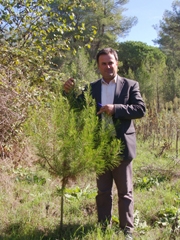
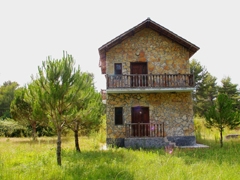
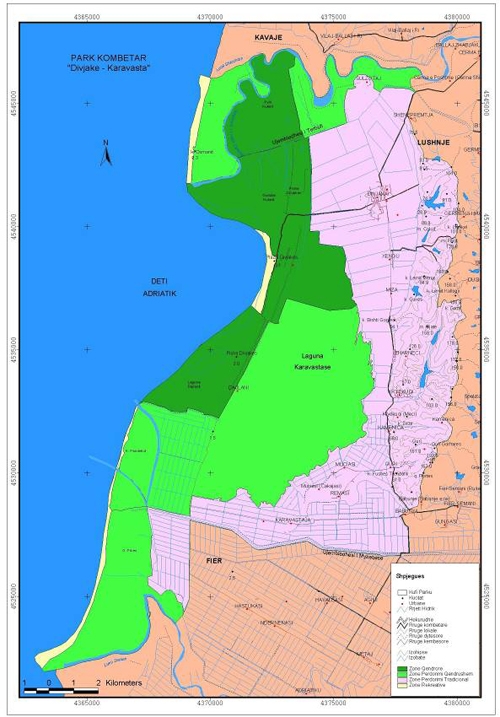 Center Zone:Dark Green
Center Zone:Dark Green
Sustainable Use Zone:Yellow Green
Traditional Use Zone:Pink
Recreation Zone:Yellow
Center Zone (Principally forests)
This zone is mostly pine tree forest that is of one of the best remaining pine tree forest along the entire Adriatic coast. It is a very important conservation area that is a home to rich biodiversity. The forest occupies the most of the area between the beach and the lagoons. There are some nature trail routes within the forest. National Park office staff makes regular patrol. Conservation is the number one priority in the zone.
However, National Park staffs wish that through appropriate use visitors to enjoy the precious natural forest.
On the other hand, negative impacts of the tourism are obvious in the area neighboring the Recreation Zone, such as development work for beach tourism, dumping of garbage and so forth are seen.
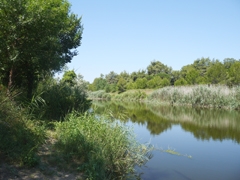
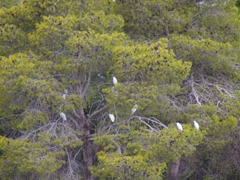
Sustainable Use Zone (Principally Lagoons)
The Karavasta Lagoon is a registered Ramsar Site, the Wetlands of International Importance. The area supports diverse species of birds and harbors a significant proportion of the European breeding populations. More than 200 birds species are observed. Among all, the most famous and important species is the Dalmatian Pelican (Pelecanus crispus) which represent the Park.
Also the naturally grown fish from the Lagoon, above all sea basses, sea breams, eels, are famous for the quality. Fishes draw large inquiries, part of them are exported directly and others are purchased by restaurants in the capital. Fish resources provide an important livelihood for many local residents.
Conservation of the Lagoon environment is essential not only for protection of birds but also for the sustainable management of fish resources.
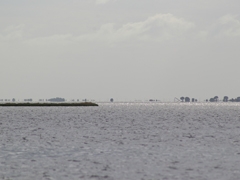
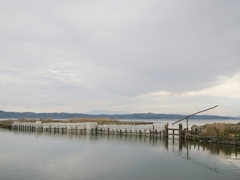
Traditional Use Zone (Principally farmland)
This zone encompasses urban areas where more than 15,000 people lives. Other land use type includes agriculture, livestock grazing, preserved forest and so forth. Olives and citrus trees cover the hill areas at the eastern end of the National Park, where the watershed forms a border of the Park.
The area is one of the prominent agricultural areas in Albania producing wide ranges of fruits and vegetables. Above all, watermelons are very famous for its quality and long lasting season from early summer till the end of autumn and are exported widely to European countries. Sustainable use in agriculture is especially important in this zone.
While agriculture plays an important role in local economical development, on the other hand negative impacts on environment through chemicals used for agriculture give shadows over human use. Especially at the area surrounding the Karavasta Lagoon, influx of such chemicals and so called "black water" raises big concern. Appropriate balance between Nature Conservation and Sustainable Use is essential in this zone too.
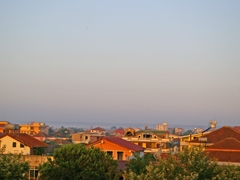
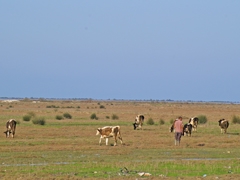
Recreation Zone (Beach Area)
The Western end of the National Park is the Adriatic Sea. In the summer months, the zone becomes so crowded with visitors from all over Albania as well as from abroad. Among all, Divjake beach is the center to the zone with good transportation links including public transport.
Divjake beach area offers services such as parking, restaurants, hotels, camping site and other services on the beach. The zone is neighboring with the forest of the Center Zone, so both sunbathing at beach and walking through woods can be enjoyed. As visitors' influx concentrate in summer months, especially during the period, sewage water treatment, garbage collection and waste management are important in terms of nature conservation.
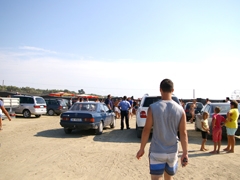
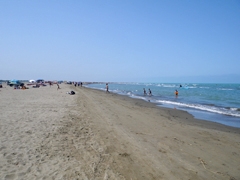
- About JICA
- News & Features
- Countries & Regions
- Our Work
- Thematic Issues
- Types of Assistance
- Partnerships with Other Development Partners
- Climate Change / Environmental and Social Considerations
- Evaluations
- Compliance and Anti-corruption
- Science and Technology Cooperation on Global Issues
- Research
- JICA Development Studies Program / JICA Chair
- Support for the Acceptance of Foreign HRs / Multicultural and Inclusive Community
- Publications
- Investor Relations
